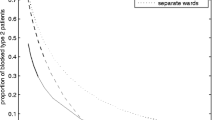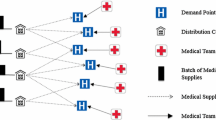Abstract
With the increasing costs of health care, service providers are looking for innovative ways to cut cost without sacrificing high service quality. Resource pooling is a promising trend in different health care areas, and sterilization is no exception. Specialized medical sterilization centers (SCs) that offer reusable medical device (RMD) sterilization services for hospitals have the potential to cut cost and improve efficiency through better utilization of resources, risk-pooling and economies of scale. However, it is unclear whether the resulting cost savings can offset the additional transportation costs and the operational complications associated with a centralized system. We compare three schemes to organize RMD sterilization in a group of hospitals: fully distributed, centralized processing, and centralized processing and stock keeping. The sterilization network design problem is formulated as a mixed-integer concave minimization program (MISOCP) that considers economies of scale, service level requirements and variable demand, with the objective of minimizing capacity, transportation, and inventory holding costs. The mathematical model is reformulated as a mixed-integer second-order cone program with a piecewise-linear cost function so it can be solved efficiently. We also consider the case when the first two moments of the RMD demand distributions are not known with certainty but are rather estimated based on sample data. We show that, with proper selection of the uncertainty structure, the robust nonlinear optimization problem can be tractably reformulated as a MISOCP as well. Testing on a realistic case study under different scenarios reveals that significant cost savings can be achieved by consolidating sterilization services. Compared to the distributed scheme, we found that cost saving in the second scheme is attributed primarily to improved resource utilization and economies of scale. Risk-pooling in the last scheme results in an additional small cost saving that has to be weighed against other operational and legal considerations.



Similar content being viewed by others
References
Atamtürk A, Narayanan V (2008) Polymatroids and mean-risk minimization in discrete optimization. Oper Res Lett 36(5):618–622
Beale EM, Forrest JJ (1976) Global optimization using special ordered sets. Math Program 10(1):52–69
Ben-Tal A, den Hertog D, Vial JP (2015) Deriving robust counterparts of nonlinear uncertain inequalities. Math Program 149(1):265–299
Berman O, Krass D, Tajbakhsh MM (2011) On the benefits of risk pooling in inventory management. Prod Oper Manag 20(1):57–71
Bertsimas D, Sim M (2004) The price of robustness. Oper Res 52(1):35–53
Burns LR, Lee JA (2008) Hospital purchasing alliances: Utilization, services, and performance. Health Care Manage Rev 33:203–215
CIHI (2012) National health expenditure trends, 1975 to 2012. Tech. rep., Canada Institute of Health Information. https://secure.cihi.ca/free_products/NHEXTrendsReport2012EN.pdf. Accessed 24 Feb 2018
Chen M, Lin C (1989) Effects of centralization on expected costs in a multi-location newsboy problem. J Oper Res Soc 40(6):597–602
Cherikh M (2000) On the effect of centralization on expected profits in a multi-location newsboy problem. J Oper Res Soc 51(6):755761
Daskin MS, Coullard CR, Shen ZJM (2002) An inventory-location model: Formulation, solution algorithm and computational results. Ann Oper Res 110(1):83–106
Davison AC, Hinkley DV (2013) Bootstrap methods and their application. Cambridge University Press, New York
Elshafei AN (1975) An approach to locational analysis. J Oper Res Soc 26:167–181
Eppen G (1979) Effects of centralization on expected costs in a multi-location newsboy problem. Manag Sci 25(5):498–501
Essoussi IE, Ladet P (2009) Towards resource pooling in cooperative health care networks: Case of medical supply centralization. In: Computers Industrial Engineering. CIE 2009. International Conference on, pp 600–605
Fineman SJ, Kapadia AS (1978) An analysis of the logistics of supplying and processing sterilized items in hospitals. Comput Oper Res 5(1):47–54
Lega F (2005) Strategies for multi-hospital networks: a framework. Health Serv Manag Res 18(2):86–99
Ontario’s Local Health Integration Networks (2018). http://www.lhins.on.ca/. Accessed 24 Feb 2018
Or I, Pierskalla WP (1979) A transportation location-allocation model for regional blood banking. AIIE Trans 11(2):86–95
Saif A, Elhedhli S (2016) Cold supply chain design with environmental considerations: a simulation-optimization approach. Eur J Oper Res 251(1):274–287
Smellie C, Quinlan M, Dueck A, Effa D (2012) Steripro operations analysis. Case study. University of Waterloo, Waterloo
Smith JE, Winkler RL (2006) The optimizer’s curse: skepticism and postdecision surprise in decision analysis. Manag Sci 52(3):311–322
TMR (2012) Sterilization equipment and disinfectants market—global industry analysis, size, share, growth, trends and forecast, 2013–2019. Tech. rep., Transparency Market Research. http://www.transparencymarketresearch.com/sterilization-equipment-market.html. Accessed 24 Feb 2018
Tlahig H, Jebali A, Bouchriha H (2009) A two-phased approach for the centralisation versus decentralisation of the hospital sterilisation service department. Eur J Ind Eng 3(2):227–246
Tlahig H, Jebali A, Bouchriha H, Ladet P (2013) Centralized versus distributed sterilization service: A location-allocation decision model. Oper Res Health Care 2(4):75–85
Vanberkel PT, Boucherie RJ, Hans EW, Hurink JL, Litvak N (2012) Efficiency evaluation for pooling resources in health care. OR Spectr 34(2):371–390
Van de Klundert J, Muls P, Schadd M (2008) Optimizing sterilization logistics in hospitals. Health Care Manag Sci 11(1):23–33
Acknowledgements
We would like to thank the anonymous reviewers for their insightful comments, which helped us to improve the manuscript.
Author information
Authors and Affiliations
Corresponding author
Rights and permissions
About this article
Cite this article
Saif, A., Elhedhli, S. Sterilization network design. EURO J Transp Logist 8, 91–115 (2019). https://doi.org/10.1007/s13676-018-0118-y
Received:
Accepted:
Published:
Issue Date:
DOI: https://doi.org/10.1007/s13676-018-0118-y
Keywords
- Healthcare operations
- Network design
- Second-order cone programming
- Piecewise linearization
- Robust optimization




